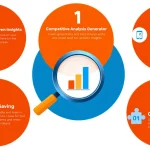Is this tool helpful?
How to Use the Competitive Pricing Analysis Tool Effectively
This comprehensive pricing analysis tool helps businesses evaluate and optimize their pricing strategies through competitive market analysis. Here’s a detailed guide on using each field effectively:
Step-by-Step Field Guide
- Company Name: Enter your business name (e.g., “TechSolutions Inc.” or “Global Foods Direct”)
- Industry/Market Sector: Specify your primary industry (e.g., “SaaS Software Development” or “Organic Food Distribution”)
- Main Competitors: List your key competitors, one per line. Include both direct and indirect competitors that target similar customer segments
- Products/Services: Detail your offerings with current pricing. Example format:
- Enterprise CRM Solution – $499/month
- Team Collaboration Tools – $99/user/month
- API Integration Package – $299/month
- Current Pricing Structure: Outline your existing pricing tiers and models
- Geographic Market: Specify target regions for market-specific analysis
Understanding the Competitive Pricing Analysis Tool
The Competitive Pricing Analysis Tool is a sophisticated market intelligence solution designed to help businesses make data-driven pricing decisions. It analyzes competitor pricing strategies, market positioning, and value propositions to identify optimal pricing opportunities.
Core Components of Analysis
- Market positioning assessment
- Competitor pricing comparison
- Value proposition analysis
- Bundle optimization opportunities
- Geographic price variation study
Benefits of Using the Pricing Analysis Tool
Strategic Advantages
- Identify pricing gaps in the market
- Optimize profit margins
- Develop competitive bundling strategies
- Track market trends and pricing patterns
- Enhance market positioning
Operational Benefits
- Streamline pricing decisions
- Reduce analysis time
- Improve pricing accuracy
- Enable data-driven strategy development
Solving Specific Business Challenges
Price Optimization Example
Consider a software company offering project management tools:
- Current Pricing: Basic ($29/month), Pro ($79/month), Enterprise ($199/month)
- Competitor Analysis Results:
- Competitor A: Basic ($39/month), Pro ($89/month), Enterprise ($249/month)
- Competitor B: Basic ($25/month), Pro ($69/month), Enterprise ($179/month)
- Tool Recommendation: Increase Basic tier to $35/month while adding additional features to justify the price increase
Bundle Optimization Case
For a digital marketing agency:
- Current Services:
- SEO Management: $1,500/month
- Social Media Management: $1,200/month
- Content Creation: $800/month
- Tool-Suggested Bundle: Comprehensive Digital Marketing Package at $2,995/month (saving clients $505 while increasing service adoption)
Practical Applications and Use Cases
Market Entry Strategy
A new e-commerce platform using the tool to:
- Analyze competitor commission rates
- Identify underserved merchant segments
- Develop competitive fee structures
- Create attractive introductory offers
Service Industry Application
A professional consulting firm utilizing the tool for:
- Hourly rate optimization
- Service package development
- Retainer pricing structure
- Market-specific rate adjustments
Frequently Asked Questions
General Questions
Q: How often should I conduct pricing analysis?
A: It’s recommended to perform comprehensive pricing analysis quarterly, with monthly monitoring of key competitors and market changes.
Q: What factors should I consider when adjusting prices?
A: Consider market positioning, competitor pricing, value proposition, customer price sensitivity, and operational costs.
Q: How can I effectively implement price changes?
A: Implement changes gradually, communicate value clearly to customers, and consider grandfathering existing customers.
Strategic Questions
Q: Should I always match competitor prices?
A: Not necessarily. Focus on your value proposition and target market positioning rather than simply matching competitors.
Q: How do I determine optimal bundle pricing?
A: Analyze individual service costs, customer purchasing patterns, and competitor bundles to create attractive packages that provide value while maintaining profitability.
Q: What’s the best way to position premium pricing?
A: Clearly communicate unique value propositions, superior features, and exceptional service quality to justify premium pricing.
Implementation Questions
Q: How can I test new pricing strategies?
A: Implement A/B testing with different customer segments or geographic markets to evaluate pricing effectiveness.
Q: What metrics should I track after pricing changes?
A: Monitor customer retention, acquisition rates, revenue per customer, market share, and profit margins.
Q: How do I communicate price changes to customers?
A: Provide advance notice, explain the value added, and consider offering loyalty incentives or grandfathered rates for existing customers.
Advanced Analysis Techniques
Value-Based Pricing Strategy
Implement value-based pricing by:
- Quantifying customer benefits
- Measuring price sensitivity
- Analyzing competitive alternatives
- Determining price-value relationships
Market Segmentation Analysis
Develop segment-specific pricing by:
- Identifying distinct customer groups
- Analyzing segment-specific needs
- Determining willingness to pay
- Creating targeted value propositions
By following these comprehensive guidelines and utilizing the tool’s capabilities, businesses can develop and maintain competitive pricing strategies that drive growth and profitability while maintaining market position.
Important Disclaimer
The calculations, results, and content provided by our tools are not guaranteed to be accurate, complete, or reliable. Users are responsible for verifying and interpreting the results. Our content and tools may contain errors, biases, or inconsistencies. We reserve the right to save inputs and outputs from our tools for the purposes of error debugging, bias identification, and performance improvement. External companies providing AI models used in our tools may also save and process data in accordance with their own policies. By using our tools, you consent to this data collection and processing. We reserve the right to limit the usage of our tools based on current usability factors. By using our tools, you acknowledge that you have read, understood, and agreed to this disclaimer. You accept the inherent risks and limitations associated with the use of our tools and services.







